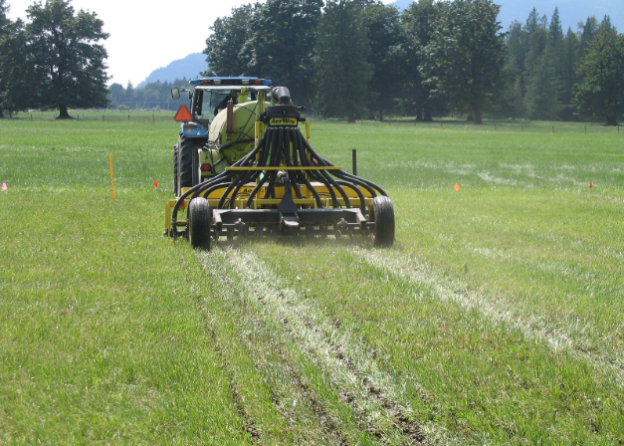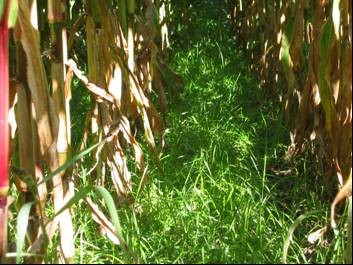Set up an interview
Media Relations
Agriculture and Agri-Food Canada
1-866-345-7972
aafc.mediarelations-relationsmedias.aac@agr.gc.ca
Did you know that a single dairy cow can produce up to 60 kilograms of manure a day? That's equivalent to the weight of the average adult human, every single day. All of this "poop" can actually be a big benefit for dairy producers because of the valuable nutrients and carbon it contains. But, if not managed well, manure can also be harmful to the environment, contributing to contaminated waterways and creating gaseous emissions, including climate-warming greenhouse gases.
The challenge for researchers: how to most efficiently access the beneficial nutrients while mitigating risks to the environment. Researchers at Agriculture and Agri-Food Canada's (AAFC) Agassiz Research and Development Centre, Shabtai Bittman and Derek Hunt, are taking up the challenge to find a safe solution to make good use out of what is too often considered a waste and a nuisance.
An innovative solution to an age-old problem
Dairy producers spread liquid manure, also known as slurry, on their fields to empty their storages and to enrich their soil and feed their crops. But it is difficult to use slurry as a primary or complete fertilizer for two main reasons:
- manure contains an imbalance of nutrients (a low nitrogen to phosphorus ratio compared to what a plant needs);
- the convenient methods of spreading the manure over the soil leads to nutrient loss, which can contribute to environmental contamination and result in higher costs when more fertilizer is needed to replace the lost nutrients.
A crop requires a delicate balance of nutrients, especially nitrogen and phosphorus, which is why dairy producers often rely on more flexible and predictable commercial fertilizers. The AAFC researchers worked to overcome the challenges of using manure, and to make it easier and cheaper for producers to use its nutrients efficiently.
"The dairy sector has improved greatly through advances in genetic and nutritional science, but more environmental improvements are needed, particularly around manure management, to reduce nutrient surpluses and improve efficiency. Of note, the Dairy Farmers of Canada have recently committed to a zero carbon future."
- Dr. Shabtai Bittman, Research Scientist, Agriculture and Agri-Food Canada
The pair found that the ratio of nitrogen and phosphorus could be changed through low-cost, solid-liquid separation by simply allowing the slurry to settle naturally in storage tanks or lagoons. The settling process resulted in two portions of the manure — a thin liquid portion relatively rich in available nitrogen, and a sludge portion rich in phosphorus, organic nitrogen and carbon. The two parts could then be applied to crops where they would be used most efficiently.
Maximizing the nutrient benefit
The next phase of their research led Bittman and Hunt to investigate how to best deliver the two portions of the manure to maximize their potential benefits and minimize losses. They discovered that using the thin liquid portion for forage grass provided more efficient nitrogen recovery because it rapidly infiltrated into the soil, reducing loss of precious nitrogen-containing ammonia gas. This thin liquid portion also had the added benefit of reducing an overload of phosphorus when applying nitrogen at the most efficient rates, because some of the phosphorous had settled as sludge to the bottom.
The uptake of nitrogen in the soil was further improved when a precision low emission applicator was attached to the manure spreading tank. The low emission applicator applied the manure uniformly in narrow bands directly on the soil, not the crop canopy like typical surface spraying. Rolling tines, which poke holes in the soil, were added to further increase infiltration of the manure into the soil. This minimized exposure of the manure to air and maximized contact with the soil to further conserve nitrogen and phosphorous and keep the grass clean of microbial contamination. Yet another added bonus: it reduced annoying odors!
One of the long-standing issues with all manure separation is what to do with the remaining thick, sludge portion. The sludge was found to be a great replacement for commercial fertilizer phosphorus for corn when precision-placed within 10 cm of the seed — in the manner of starter commercial fertilizer. In practice, the manure is injected about two days before precision planting corn. Bittman and Hunt also found that a cover crop of Italian ryegrass seeded between the corn rows a few weeks after corn planting reduced the risk of nitrogen leaching in fall, formed a protective winter cover for the soil and provided farmers with a high quality crop in early spring (see photo). This cover crop also improves milk quality (more butterfat) and revenue for farmers!
Dairy farms that have a limited land base, such as those farms located in peri-urban regions (areas where agriculture occurs within or near population centres, like British Columbia's Fraser Valley) can particularly benefit from these findings. By tightening nutrient management, the technologies will improve land use, safeguard food supplies and protect people and environment. As these regions tend to have intensive production and import a lot of nutrients in fertilizers and imported feed, it is especially important to mitigate excesses.
Key benefits
- Allowing liquid dairy cow manure to settle in storage tanks or lagoons results in a thin liquid relatively rich in available nitrogen, and a sludge rich in phosphorus, organic nitrogen and carbon. These two portions can be applied to crops where they will be used most efficiently
- Making better use of manure nutrients reduces the need for commercial fertilizers, lowering costs and improving the environmental footprint of dairy farming
- Precision placing the nutrients where they're needed helps to further mitigate nutrient loss from the soil
Photo gallery

Separated liquid slurry is applied with a surface banding applicator to reduce exposure to the air and encourage soil infiltration. Very little manure is left on the surface with no soil disturbance.

Italian ryegrass under seeded into corn in spring is fully established when corn is harvested, providing soil protection and capturing nutrients in fall and winter.